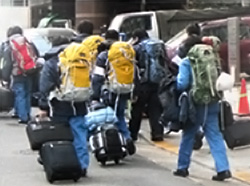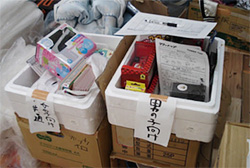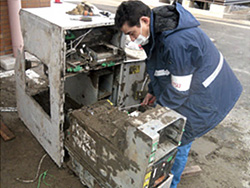Archived content
NOTE: this is an archived page and the content is likely to be out of date.
Reaching out in times of disaster
Japan's most powerful earthquake since records began struck the north-east coast on March 11, 2011, triggering a massive tsunami that claimed the lives of some 20,000 people. The tsunami and earthquake together caused widespread damage across north-eastern Japan, resulting in the progressive and cascading breakdown of critical infrastructure services and technological systems – including energy, telecommunications, transport, water, sanitation and healthcare. The manufacturing industry faced massive supply chain disruptions and business continuity was compromised across most sectors. Especially in the immediate aftermath, power cuts and communications in general were particularly problematic as both mobile and landline infrastructures were damaged and overloaded.
 We responded immediately to the crisis, donating funds and marshalling resources to support the restoration of daily life and the rebuilding of social infrastructure in the disaster area. Various information and communication technologies and services which we delivered increased the efficiency and success of relief and rebuild work. In acknowledgement of our contribution, we have been awarded the Computerworld 21st Century Achievement Award for our fast and innovative response to the Japanese earthquake and tsunami. This program honors individuals and organizations who create and use information technology to promote and advance public welfare, contribute to the greater good of society and change the world for the better.
We responded immediately to the crisis, donating funds and marshalling resources to support the restoration of daily life and the rebuilding of social infrastructure in the disaster area. Various information and communication technologies and services which we delivered increased the efficiency and success of relief and rebuild work. In acknowledgement of our contribution, we have been awarded the Computerworld 21st Century Achievement Award for our fast and innovative response to the Japanese earthquake and tsunami. This program honors individuals and organizations who create and use information technology to promote and advance public welfare, contribute to the greater good of society and change the world for the better.
Building a social support network
The first line of action focused in particular on information. The challenge lay in establishing the needs of local evacuation centers so that relief workers could deliver the medical and care services actually needed on the ground. Drawing on our extensive experience in the rapid delivery of cloud-based services to support efforts to contain the spread of epidemics, our Disaster Support Teams quickly developed a cloud-based, real-time information solution (spanning hardware, software and services) that allowed evacuation centers to align the efforts of non-profit organizations with the concrete needs of disaster victims. The Support Teams also delivered software-as-a-service (SAAS) applications such as CRMate to help gather and share real-time damage and safety information. In addition, we loaned 2000 PCs free of charge to over 100 evacuation centers to give local people access to the Internet and allow residents outside the disaster area to stay in touch with evacuees.
 The earthquake highlighted the potential benefits of social media in emergency situations. Social networks proved invaluable in establishing the safety and whereabouts of evacuees and in recruiting volunteers, including Fujitsu employees. The volunteers were instrumental in helping to clear rubble, search for lost pets and deliver relief supplies. To support social networking, we provided applications, services, storage facilities and PCs. Equally important on the information front was the need to immediately establish the impact of the earthquake so an appropriate response plan could be quickly put in place. Here, we supported the Japan Aerospace Exploration Agency (JAXA) initiative, which shares satellite images of typhoons, floods, earthquakes, tsunamis and other natural disasters in the Asia-Pacific region over the Internet. After the earthquake, the BI.DAN-GUN high-speed file transfer solution which we developed for JAXA's Sentinel Asia STEP-2 observation system rapidly provided satellite imagery of the affected region.
The earthquake highlighted the potential benefits of social media in emergency situations. Social networks proved invaluable in establishing the safety and whereabouts of evacuees and in recruiting volunteers, including Fujitsu employees. The volunteers were instrumental in helping to clear rubble, search for lost pets and deliver relief supplies. To support social networking, we provided applications, services, storage facilities and PCs. Equally important on the information front was the need to immediately establish the impact of the earthquake so an appropriate response plan could be quickly put in place. Here, we supported the Japan Aerospace Exploration Agency (JAXA) initiative, which shares satellite images of typhoons, floods, earthquakes, tsunamis and other natural disasters in the Asia-Pacific region over the Internet. After the earthquake, the BI.DAN-GUN high-speed file transfer solution which we developed for JAXA's Sentinel Asia STEP-2 observation system rapidly provided satellite imagery of the affected region.
Enabling business continuity
Parallel to these efforts, we concentrated on re-establishing business continuity and supply chain efficiency – both at our own business locations and our customers' premises. By April 20, 2011 we had restored lifelines (electricity, water and gas supplies) and normal operations to all 50 of our business locations in eastern Japan.
 To collect and share information on damage, restoration and maintenance status, we set up a disaster damage website for our customers. We provided special repair and maintenance services, strengthening our regular maintenance team with an additional 1,500 support workers. These were dispatched every day from all over Japan to help restore customers' supporting social infrastructures, such as local government, hospitals and financial institutions. We also worked with our partners to restore supplies interrupted by earthquake damage, rapidly finding alternative components and suppliers where necessary. Dedicated emergency contacts were available to help with technical queries from customers and the disaster website provided guidance and checklists to ensure that customers could resume normal operations after rolling power cuts.
To collect and share information on damage, restoration and maintenance status, we set up a disaster damage website for our customers. We provided special repair and maintenance services, strengthening our regular maintenance team with an additional 1,500 support workers. These were dispatched every day from all over Japan to help restore customers' supporting social infrastructures, such as local government, hospitals and financial institutions. We also worked with our partners to restore supplies interrupted by earthquake damage, rapidly finding alternative components and suppliers where necessary. Dedicated emergency contacts were available to help with technical queries from customers and the disaster website provided guidance and checklists to ensure that customers could resume normal operations after rolling power cuts.
On the medical front, we are also committed to leveraging information and communication technologies (ICT) to ensure continuity of health care and easy access to medical records from evacuation and emergency centers. Innovations here include our private cloud-based Human Bridge Disaster Prevention Solution for medical institutions, based on a high-reliability, high-performance backup system, which can be accessed from anywhere.
Looking ahead
Our engagement with recovery operations and initiative in building collaborative healthcare hubs has sharpened our understanding of the critical role that ICT plays in establishing business continuity, building healthcare and social networks and delivering lifeline services (such as water, energy and food) to citizens over a broad geographical area in times of disaster. We have channelled the experience gained from the earthquake disaster into our business continuity plans, focusing in particular on how to get healthcare and emergency systems back up and running as quickly as possible. Our aim is to ensure that these services are delivered to citizens even more rapidly in future. In addition to maximizing the potential value of cloud services and SAAS applications, we are also working to reduce dependency on electricity in particular, with a view to mitigating the cascade effect as infrastructure services and technological systems are disrupted.
We have partnered, for example, with Daiwa House Industry Co. and other companies to build an earthquake-resilient, environmentally friendly urban community in a Chiba Prefecture city damaged by the March earthquake. At an estimated cost of some 50 billion yen through 2020, the smart city will use solar power to reduce dependency on grid electricity.
